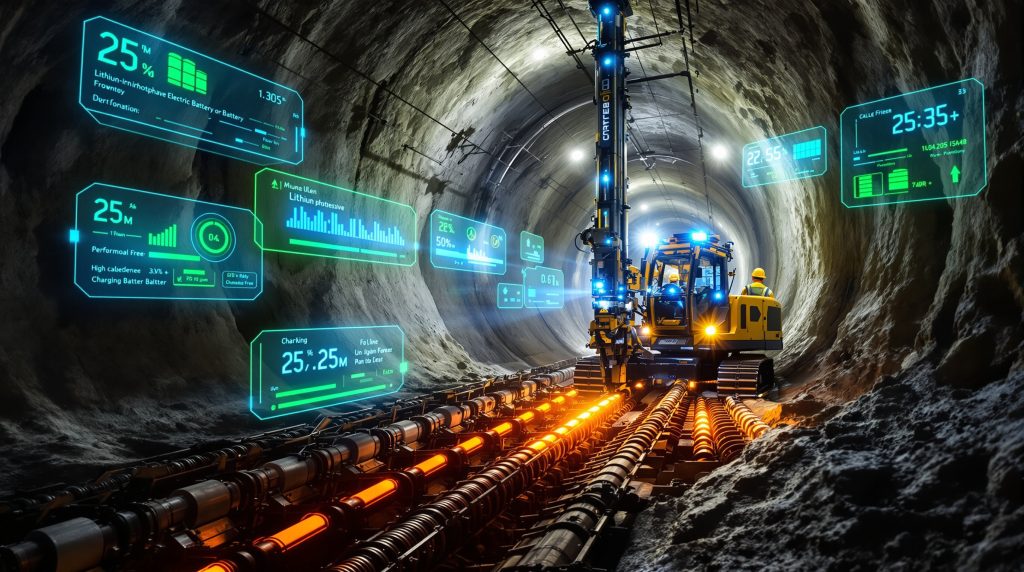Why Modern Underground Mining Operations Require Battery-Powered Cable Bolter Technology
Underground mining environments face critical safety and operational challenges that traditional diesel-powered equipment cannot adequately address. The release of the Sandvik DS422iE represents a breakthrough moment, marking the arrival of the world's first commercial battery-powered cable bolter designed specifically for underground mining applications.
Modern mining operations demand zero-emission solutions that maintain productivity while protecting worker health in confined spaces. Battery-powered cable bolters eliminate diesel exhaust emissions entirely, transforming air quality standards in underground workings and reducing the strain on ventilation systems that consume substantial energy resources.
The operational independence provided by advanced battery technology creates new possibilities for mining operations with unstable electrical infrastructure. Off-grid capability enables continuous rock reinforcement work in areas where electrical networks prove unreliable or unavailable, enhancing operational flexibility and reducing downtime.
Key advantages driving adoption:
- Zero emissions across tramming, drilling, bolting, and grouting operations
- Substantial reduction in heat generation compared to diesel systems
- Enhanced air quality improving worker health and safety conditions
- Reduced ventilation requirements leading to energy cost savings
- Operational independence through battery power capability
Understanding Cable Bolt Systems in Underground Rock Reinforcement
Cable bolts serve as critical long-term structural reinforcement systems in underground excavations, consisting of high-tensile steel strands installed in grouted holes to provide stability for mine tunnels, shafts, and working areas. These systems extend substantially beyond traditional rock bolt capabilities, with modern equipment capable of installing cable bolts up to 25 meters in length.
The Sandvik DS422iE incorporates multi-strand cable installation technology, enabling the placement of several steel strands per hole to maximize structural integrity. This configuration provides superior load distribution and long-term stability compared to single-strand systems, particularly in challenging geological conditions requiring enhanced support.
Technical specifications for cable bolt installation:
| Component | Specification | Advantage |
|---|---|---|
| Maximum cable length | Up to 25 meters | Extended structural support range |
| Steel strand configuration | Multiple strands per hole | Enhanced load distribution |
| Cement silo capacity | 600kg | Reduced manual handling requirements |
| Installation method | Cement grouted | Long-term stability and corrosion protection |
Automated Cement Mixing and Delivery Systems
Modern battery-powered cable bolter technology integrates automated cement mixing and delivery systems that eliminate manual handling between holes. The DS422iE features an onboard automatic cement mixer with a 600kg capacity silo, streamlining the grouting process and reducing labour requirements while maintaining consistent installation quality.
Traditional cable bolting operations require frequent manual refilling and mixing of cement materials, creating safety risks and operational delays. Furthermore, automated systems eliminate these inefficiencies while ensuring proper grout consistency and placement throughout the installation process.
Advanced Battery Technology Revolutionising Underground Equipment
Lithium-iron phosphate (LFP) battery chemistry represents the optimal power solution for underground mining applications, providing maximum safety while delivering superior productivity and equipment utilisation compared to other battery technologies. LFP chemistry offers enhanced thermal stability, reducing fire risks in confined mining environments where traditional lithium-ion variants could pose safety concerns.
The revolutionary charging-while-drilling technology patented by Sandvik enables continuous operation even in areas without electrical network access. This proprietary system allows the battery-powered cable bolter to execute complete drilling cycles on battery power, with operational capability extending up to four hours in off-grid conditions.
LFP battery advantages in underground mining:
- Superior thermal stability compared to NCA or NMC lithium-ion chemistries
- Reduced thermal runaway risk in confined underground spaces
- Enhanced cycle life supporting intensive mining duty cycles
- Consistent power delivery throughout discharge cycles
- Optimal safety profile for underground equipment applications
Electric Driveline System Performance Benefits
Electric driveline systems eliminate fuel consumption entirely while generating substantially less heat and noise than conventional diesel systems. In addition, AI in mining operations demonstrates how revolutionary electric technology transforms underground operations by reducing thermal stress on ventilation systems and creating safer working conditions for mining personnel.
Heat reduction becomes particularly critical in deep underground workings where thermal management directly impacts worker comfort and safety. Electric systems generate minimal waste heat compared to diesel engines, reducing the burden on cooling and ventilation infrastructure while improving overall environmental conditions.
Noise reduction benefits include:
- Enhanced communication between crew members during operations
- Improved detection of potential safety hazards
- Reduced occupational hearing risks for equipment operators
- Better integration with automated monitoring systems
Operational Performance and Technical Capabilities
The battery-powered cable bolter delivers equivalent performance to diesel counterparts while providing significant operational advantages. The DS422iE builds upon proven diesel machine features, incorporating one-hole automation, repeatable bolting accuracy, tele-remote operation capabilities, and comprehensive fan automation systems.
Performance comparison analysis:
| Performance Metric | Battery-Powered DS422iE | Traditional Diesel Systems |
|---|---|---|
| Cable bolt length capacity | Up to 25 meters | Up to 25 meters |
| Off-grid operation duration | 4+ hours continuous | Limited by fuel capacity |
| Emission output | Zero emissions | Significant diesel exhaust |
| Cabin visibility improvement | 55% enhanced | Baseline configuration |
| Heat generation | Minimal thermal output | High heat generation |
| Operational noise | Substantially reduced | Standard diesel noise levels |
Advanced Automation and Digital Integration
Modern data-driven mining operations integrate comprehensive automation features that enhance installation consistency and operational efficiency. One-hole automation ensures repeatable bolting accuracy while reducing human error factors that can compromise installation quality.
Tele-remote operation capabilities enable equipment operation from safe distances in hazardous underground areas, protecting operators while maintaining productivity. However, full fan automation optimises ventilation requirements based on operational conditions, reducing energy consumption and improving air quality management.
Digital system integration includes:
- iSURE performance monitoring and optimisation
- DrillConnect remote monitoring and diagnostics
- Digital Driller operational interface and control
- My Sandvik comprehensive fleet management
The ergonomically designed cabin provides 55% increased visibility compared to traditional models, enhancing operator safety and precision during cable bolt installation. Improved visibility reduces eye strain and operator fatigue while enabling more accurate equipment positioning and installation procedures.
Enhanced Safety and Health Benefits in Confined Spaces
Zero-emission operation fundamentally transforms air quality in underground mining environments, eliminating diesel exhaust particles and reducing respiratory health risks for mining personnel. The absence of combustion emissions reduces ventilation system requirements, leading to energy savings and improved working conditions throughout underground operations.
Air quality improvements deliver:
- Elimination of diesel particulate matter (PM2.5 and PM10)
- Reduced nitrogen oxide (NOx) and sulfur compound exposure
- Decreased carbon monoxide levels in confined spaces
- Enhanced overall respiratory health protection for workers
Thermal Comfort and Noise Reduction Impact
Electric drive systems generate minimal heat compared to diesel engines, reducing thermal stress in underground environments where temperature management proves critical for worker safety and comfort. Consequently, reduced heat generation decreases the burden on ventilation systems while creating more comfortable working conditions.
Substantial noise reduction enables improved communication between crew members during critical operations, enhancing safety coordination and hazard detection capabilities. Lower noise levels also reduce occupational hearing risks and support better integration with automated monitoring systems that rely on acoustic detection.
Ergonomic and visibility enhancements include:
- 55% improved visibility reducing operator eye strain
- Enhanced precision during cable bolt installation procedures
- Reduced operator fatigue over extended work shifts
- Better detection of potential safety hazards in the work environment
Economic Advantages and Cost Optimisation
Battery lithium refinery technology eliminates fuel consumption entirely, providing immediate operational cost savings while reducing dependency on diesel fuel supply chains. Electric driveline systems require substantially less maintenance than complex diesel engines, reducing downtime and maintenance expenses while improving overall equipment availability.
Maintenance reduction stems from simplified electric systems with fewer moving parts compared to diesel engines. Furthermore, elimination of fuel system maintenance, emission control system servicing, and complex engine overhauls creates significant cost advantages over equipment lifecycles.
Economic benefits include:
- Complete elimination of diesel fuel costs
- Reduced maintenance requirements and associated labour costs
- Improved equipment availability through reduced downtime
- Lower total cost of ownership over equipment lifecycle
- Enhanced productivity through digital integration capabilities
Digital Integration and Productivity Enhancement
Comprehensive digital monitoring systems provide real-time performance oversight, predictive maintenance scheduling, and production optimisation analytics. Remote diagnostics capabilities enable proactive maintenance planning, reducing unexpected failures and associated downtime costs.
The DS422iE integrates seamlessly with Sandvik's digital platform, providing fleet management capabilities that optimise equipment utilisation and operational efficiency. Digital integration enables data-driven decision making and continuous improvement in underground operations.
Digital system capabilities:
- Real-time equipment performance monitoring
- Predictive maintenance alerts and scheduling
- Remote troubleshooting and diagnostic capabilities
- Production optimisation through data analytics
- Comprehensive fleet management and reporting
Implementation Considerations for Mining Operations
Successful deployment of battery-powered cable bolter technology requires evaluation of existing electrical infrastructure and charging capabilities. Mining operations must assess current electrical capacity and potentially upgrade systems to support battery-electric fleet integration and charging requirements.
The four-hour off-grid operational capability provides significant flexibility for mines with unstable electrical networks or areas where electrical infrastructure remains limited. For instance, charging-while-drilling technology extends operational range beyond traditional battery limitations, enabling continuous work in challenging electrical environments.
Infrastructure requirements include:
- Adequate electrical supply for charging operations
- Charging station installation and integration
- Electrical system upgrades to support fleet electrification
- Safety protocols for battery charging in underground environments
Training and Operational Transition
Transitioning to battery-electric equipment requires comprehensive operator training covering battery management, digital system operation, and safety protocols specific to electric equipment. Training programmes must address operational differences between diesel and electric systems while maintaining productivity standards.
Training components include:
- Battery charging and management procedures
- Digital system operation and monitoring
- Electric equipment safety protocols
- Maintenance procedures for battery and electric systems
- Emergency response procedures for electric equipment
Environmental Impact and Sustainability Benefits
Mining sustainability transformation through battery-powered systems contributes significantly to mining operations' decarbonisation goals by eliminating direct emissions from underground rock reinforcement activities. When powered by renewable energy sources, these systems achieve near-zero carbon footprint for cable bolting operations.
Environmental benefits extend beyond emission elimination to include reduced noise pollution, elimination of diesel fuel storage and handling risks, and decreased thermal pollution in underground environments. These improvements support broader environmental stewardship goals while meeting increasingly stringent regulatory requirements.
Sustainability advantages:
- Zero direct operational emissions
- Reduced carbon footprint when powered by renewable energy
- Elimination of diesel fuel storage and spillage risks
- Decreased noise pollution in underground environments
- Support for corporate sustainability and ESG commitments
Regulatory Compliance and Future-Proofing
Increasing environmental regulations favour zero-emission underground equipment, making battery-electric systems essential for long-term regulatory compliance. Battery-powered cable bolter technology positions mining operations ahead of anticipated emission standards while potentially qualifying for environmental incentives and carbon credit programmes.
Regulatory trends indicate continued strengthening of underground air quality standards and emission limits, making early adoption of battery-electric equipment a strategic advantage for mining operations planning long-term sustainability.
Future Technology Development and Market Evolution
Battery technology continues advancing rapidly, promising enhanced capabilities including improved energy density, faster charging systems, and extended operational ranges. Furthermore, electric equipment advancements will likely include enhanced cold-weather performance for diverse mining climates and deeper integration with autonomous operation systems.
Technology evolution trends include:
- Increased energy density enabling longer operational cycles
- Faster charging capabilities reducing equipment downtime
- Enhanced thermal management for extreme operating conditions
- Integration with autonomous mining systems and remote operation
- Improved battery lifecycle and recyclability
Market Adoption and Industry Transformation
Industry analysts project significant growth in battery-powered underground mining equipment adoption, driven by strengthening environmental regulations, improving battery economics, and growing emphasis on worker health and safety. The introduction of the first commercial battery-powered cable bolter marks a pivotal moment in mining industry electrification.
Market drivers supporting adoption include corporate sustainability commitments, regulatory pressure for emission reductions, and demonstrated operational advantages of electric equipment in underground environments. Early adopters gain competitive advantages through improved safety, reduced operating costs, and enhanced regulatory compliance.
Frequently Asked Questions
How long can battery-powered cable bolters operate without charging access?
Current generation battery-powered cable bolter systems can operate continuously for more than four hours without electrical network access, utilising patented charging-while-drilling technology to extend operational time beyond traditional battery limitations.
What maintenance requirements apply to battery-electric systems?
Battery systems require periodic capacity testing, thermal monitoring, and scheduled replacement according to manufacturer specifications. However, overall maintenance requirements typically decrease significantly compared to diesel engines due to fewer moving parts and simplified mechanical systems.
Can battery-powered systems match diesel equipment performance?
Modern battery-powered cable bolter systems deliver equivalent or superior performance to diesel counterparts while providing additional benefits including zero emissions, reduced noise, enhanced digital capabilities, and improved operator visibility and comfort.
What charging infrastructure is required for implementation?
Implementation requires adequate electrical supply capacity for charging operations, with specific requirements varying based on fleet size and operational schedules. Charging-while-drilling technology reduces infrastructure demands by enabling operation in areas with limited electrical access.
Strategic Value of Battery-Powered Cable Bolting Technology
Battery-powered cable bolter systems represent a fundamental transformation in underground mining operations, delivering immediate safety and environmental benefits while positioning operations for long-term sustainability and regulatory compliance. The combination of zero-emission operation, advanced automation, and comprehensive digital integration creates compelling value propositions for mining companies.
The introduction of the Sandvik DS422iE as the world's first commercial battery-powered cable bolter establishes new industry standards for underground rock reinforcement equipment. Early adoption provides competitive advantages through improved worker safety, reduced operational costs, enhanced environmental performance, and future-proofing against evolving regulatory requirements.
As battery technology continues advancing and costs decrease, widespread adoption of battery-electric underground mining equipment appears inevitable. Consequently, mining operations that embrace this technology early gain strategic advantages in safety, sustainability, and operational efficiency that will prove increasingly valuable in the evolving mining industry landscape.
Disclaimer: This article contains forward-looking statements regarding technology development and market trends. Actual performance, adoption rates, and technological advancement may vary from projections discussed. Mining operations should conduct thorough technical and economic evaluations before implementing new equipment technologies.
Exploring Battery-Powered Mining Technology Investments?
Discovery Alert's proprietary Discovery IQ model instantly identifies significant ASX mineral discoveries related to critical battery materials and mining technology innovations, helping subscribers capitalise on the electric mining revolution. Explore how major mineral discoveries can generate exceptional returns and begin your 30-day free trial today to position yourself ahead of the market in this rapidly evolving sector.




